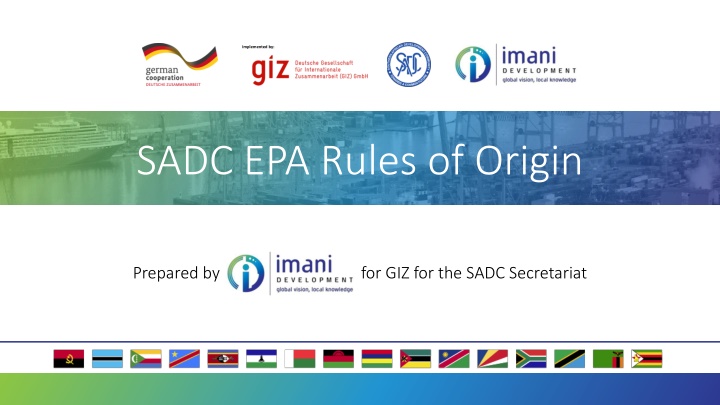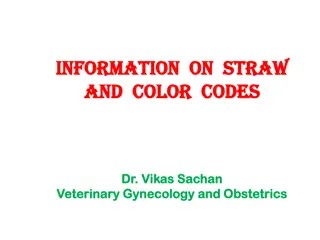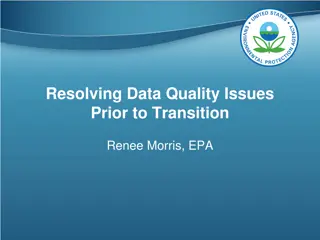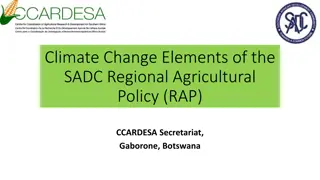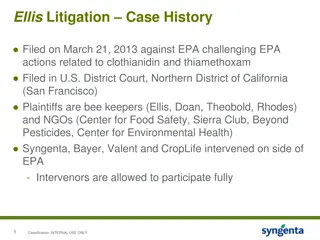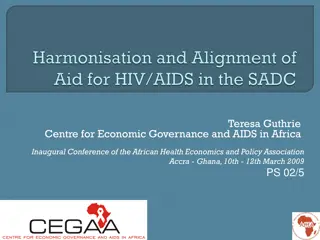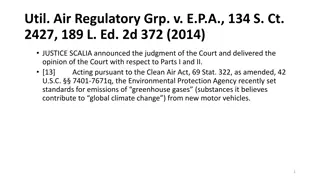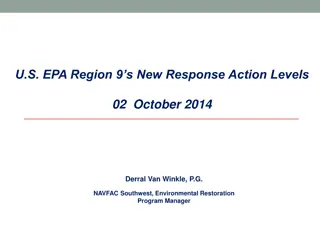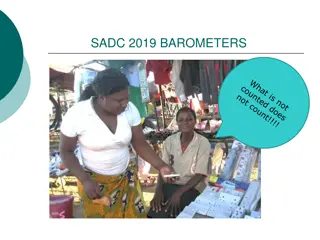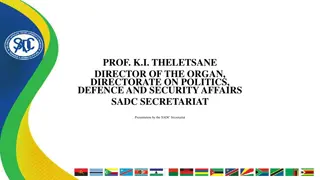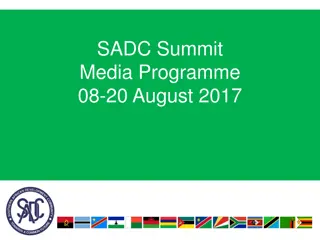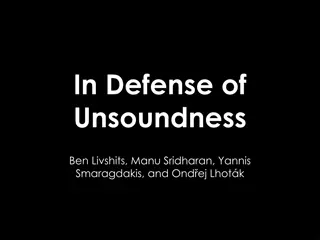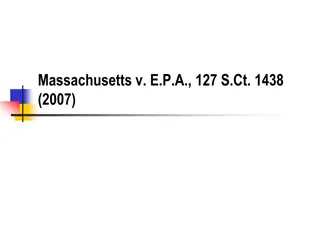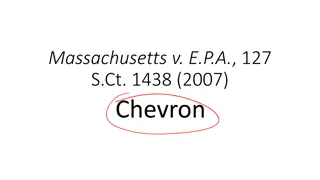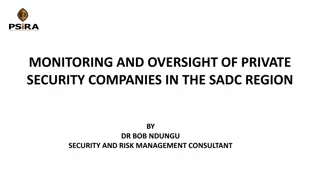Technical Soundness of EU-SADC EPA Rules of Origin
The implementation and technical soundness of Rules of Origin under the EU-SADC EPA are crucial for the utilization of trade preferences. Compliance with rules of origin is essential for receiving tariff preferences, but drafting these rules accurately is challenging. Recommendations include specifying value-added requirements and considering tariff heading changes. Specific examples for products like refrigerators and machines for wood industries are discussed in detail to illustrate the complexity of origin determinations.
Download Presentation

Please find below an Image/Link to download the presentation.
The content on the website is provided AS IS for your information and personal use only. It may not be sold, licensed, or shared on other websites without obtaining consent from the author.If you encounter any issues during the download, it is possible that the publisher has removed the file from their server.
You are allowed to download the files provided on this website for personal or commercial use, subject to the condition that they are used lawfully. All files are the property of their respective owners.
The content on the website is provided AS IS for your information and personal use only. It may not be sold, licensed, or shared on other websites without obtaining consent from the author.
E N D
Presentation Transcript
Implemented by: SADC EPA Rules of Origin Prepared by for GIZ for the SADC Secretariat
Implemented by: SADC EPA Rules of Origin Session 9: Index of Technical Soundness
Session 9: Index of Technical Soundness EU-SADC EPA Rules of Origin Defining the Index of Technical Soundness Rules of origin - often the main cause of low utilisation of autonomous trade preferences and FTAs. The existence of trade preferences does not automatically imply that the tariff preference is granted at the time of customs clearance. Tariff preferences are conditional upon compliance with rules of origin and its ancillary requirements such as documentary evidence and consignment requirements. v There are accepted techniques of drafting adequate rules origin. But misunderstandings may occur when drafting rules of origin - may easily have negative effects once these rules, which may not reflect commercial realities and manufacturing capacity, have to be administered and applied in the field. Recent recommendations for rules origin which require 10% value added Some studies recommend rules of origin under EPA should be a change of tariff heading for all products. Some studies have suggested rules of origin could either be the CTH requirement at four-digit level, or a 35% value addition based on CIF input costs.
Session 9: Index of Technical Soundness EU-SADC EPA Rules of Origin HS Heading Number Description of Product Working or processing carried out on non originating materials that confers originating status (1) (2) (3) or (4) 8418 Refrigerators, refrigerating or freezing equipment, electric or other; heat pumps other than air conditioning machines of heading No 8415 freezers and other Manufacture in which: all the materials used are classified within a heading other than that of the product; the value materials used does not exceed 40 % of the ex works price of the product; the value of all the non originating materials used does not exceed the value of the originating materials used Manufacture in which the value of all the materials used does not exceed 25 % of the ex works price of the product v of all the Are the working or processing carried out on non originating materials that confers originating status in column 3 equivalent to those in Column 4?
Session 9: Index of Technical Soundness EU-SADC EPA Rules of Origin HS Heading Number Description of Product Working or processing carried out on non originating materials that confers originating status (1) (2) (3) or (4) Ex 8419 Machines for wood, paper pulp and paperboard industries Manufacture: in which the value of all the materials used does not exceed 40 % of the ex works price of the product; where, within the above limit, the classified within the same heading as the product are only used up to a value of 25 % of the ex works price of the product Manufacture in which the value of all the materials used does not exceed 25 % of the ex works price of the product v materials Are the working or processing carried out on non originating materials that confers originating status in column 3 equivalent to those in Column 4?
Session 9: Index of Technical Soundness EU-SADC EPA Rules of Origin The merits and limits of the change of tariff classification HS heading no. 18.01 Cocoa beans 18.02 Cocoa shells 18.03 Cocoa paste 18.04 Cocoa butter 18.05 Cocoa powder 18.06 Chocolate, etc. v In this example, the HS reflects the manufacturing chain of a chocolate bar. The rule of origin for Chapter 18 is: Manufacture in which: all the materials used are classified within a heading other than that of the product; and the value of any materials of Chapter 17 used does not exceed 30 % of the ex works price of the product The CTH requirement may be considered liberal because, for instance, breaking the cocoa beans to obtain the cocoa shells is an origin conferring operation; making butter from cocoa paste a manufacturing process, including refining; while purifying the cocoa paste is also an origin conferring operation. It may be argued that breaking the beans is a rather simple operation when compared to making cocoa butter and such possible inequalities are the natural implication of the use of an across-the-board CTH.
Session 9: Index of Technical Soundness EU-SADC EPA Rules of Origin v This example shows the manufacturing chain of steel products like bars and rods from iron ores. The CTH requirement shows quite liberal implications, because each stage of the manufacturing process is origin conferring. PSRO for ex Chapter 25: Manufacture in which all the materials used are classified within a heading other than that of the product
Session 9: Index of Technical Soundness EU-SADC EPA Rules of Origin The EU-SADC EPA ROO use a maximum value of non-originating material. This is different to some Rules of Origin which use a value-added criterion. In work that has been done by the UNCTAD Working Groups and evidence drawn from questionnaires submitted to exporters and producers, it would seem that exporters/manufacturers prefer the adoption of a maximum imported inputs allowance rather than a minimum value-added requirement. There are two reasons for this preference: 1) The percentage calculation of the value of the imported input is easier to calculate and the value of the imported input can be supported by suppliers invoices. The term value of imported material , rather than being left vague and subject to the discretion of customs authorities, can be anchored to the customs value as determined in accordance with the Agreement on Implementation of Article VII of the GATT 1994; and v 2) The calculation of the value added is complex as it entails: A distinction of costs, which could be calculated as local value added; The itemisation of such cost to the single unit of production, which often requires accounting, while discretion may be used in assessing unit costs. Additionally, currency fluctuations in beneficiary countries may affect the value of the calculation; and Low labour costs in developing countries may result in low value added and instead of being a factor of competitiveness, may turn out to penalise producers.
Session 9: Index of Technical Soundness EU-SADC EPA Rules of Origin - There are important differences in the formulation of the numerator and denominator used in the calculation of percentages. - The major differences in the numerator reflect two approaches: one places a maximum limit on the use of imported material, and the other places a minimum limit on the domestic content contribution of the preference-receiving country. - Some preference-giving countries apply interpretative definitions in both approaches. Where importedmaterial is used as numerator, the method of its valuation is defined. v - Where domesticcontent is used, the elements it may comprise are, to varying degrees, defined to identify those that may be included in the calculation of the numerator and those that may not. - As a rule of thumb, the larger the denominator in the case of a value-added criterion, the more stringent the requirement of certain percentages of valued added may be. While in the case of import content criteria, the larger the denominator, the more lenient the limitation on the use of imported inputs may be. - The formulation of denominators calls for figures which appear to be readily accessible and determinable.
Session 9: Index of Technical Soundness EU-SADC EPA Rules of Origin African FTAs often use the CIF price as the denominator, but this disadvantages land-locked and island countries as the value of imported inputs will be exceeding the value of similar inputs used in another country that is not landlocked. The FOB price would assist all exporters in a preference-receiving country, irrespective of their location and efficiency, to meet a percentage requirement based on import content. The advantages the FOB price may have over the other formulations include: v It is the most frequently quoted price level and is used in international trade. It is thus readily available for use in establishing origin without additional effort or expense; The administrative overheads for manufacturers are therefore reduced to a minimum, comparing favourably with both factory cost and factory price, where detailed definitions have to be observed; and It includes some important elements which are excluded by other formulations and which may be regarded as originatingelements , for example local transport and insurance, packing and handling costs.
Session 9: Index of Technical Soundness EU-SADC EPA Rules of Origin Drafting a protocol on rules of origin requires elements and provisions that may be summarised as follows: Definitions of terminology; General requirements; Wholly obtained products including the definition of vessels; Substantial transformation: definition of appropriate methodology; v Insufficient working or processing operations; Tolerance rules; Cumulation; Allocation of origin in cumulation; and Definition of administrative rules concerning proof of origin and related trade facilitation aspects.
Implemented by: SADC EPA Rules of Origin Thank You End of Session 9
